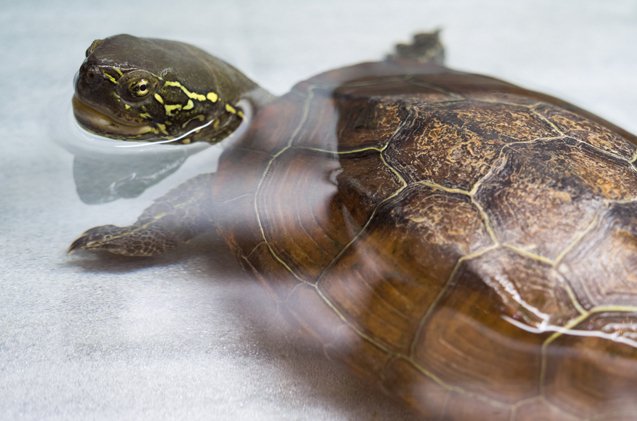Reeve’s Turtle


About Reeve’s Turtle
The Reeve’s Turtle, which is also known as the Chinese Pond Turtle, is a popular breed in the pet world, and it has a great personality that makes it a good choice for those who are beginners at keeping turtles as pets.
The Reeve’s Turtle, which is also known as the Chinese Pond Turtle, is a popular breed in the pet world.
You can find this breed living in eastern and central China, South Korea, North Korea, Japan, and Taiwan. These turtles prefer still water or slow-moving water, such as small streams, ponds, and lakes that have plenty of aquatic plants and basking areas, along with soft substrate. However, Reeve’s Turtles have also been found in flooded rice paddies, marshes, and swamps.
The shell of a Reeve’s Turtle could be described as a bit rectangular. The carapace has three keels that run down the length of it. These become less pronounced as the turtle gets older and the keels become increasingly worn over time.
It could be difficult to differentiate between a male and a female Reeve’s Turtle. However, you might notice that the plastron on a female will be either slightly convex or flat, while the plastron on a male will be concave. The tail of a male will also be thicker and longer compared to that of a female.
The Reeve’s Turtle has a great personality that makes it a good choice for beginners.
The Reeve’s Turtle features a carapace that could be anywhere from olive green to tan or even black, and there might also be subtle smudging that provides a bit of contrast in the coloration. Also, the plastron will be tan, yellow, or cream, along with dark brown, black, or gray smudges on the scutes. And the scutes’ seams could be lighter in color than the overall base color of the plastron and carapace.
The color of this turtle’s skin will be similar to the color of its carapace. You will also notice yellow stripes creating patterns on the head and neck, but these could vary from one turtle to another. Typically, there could be yellow to cream colored speckling, mottling, or striping. Also, the scales on the legs might feature lighter hues as well.
Even though males and females will be the same in terms of color while they are young, as they get older, males could become darker.
Although Reeve’s Turtles are active in their enclosures, these animals are not considered the best swimmers, so shallow water is recommended for them. Ensure that the water is deep enough, however, that your turtle will be able to turn around and avoid drowning. And your turtle should also be able to climb, rather than swim, to the surface. So if your turtle is 4” long, the water should be at least 6” deep, while a 2” turtle would need water that is 3” deep.
You could keep one adult in a 50-gallon or larger tank. For every additional adult turtle, add another 15 gallons of space. And you could house your turtle indoors or outside, provided that you are able to protect your pet from temperature extremes, escape, and predators.
Offer your turtle various plants for hiding and climbing, as well as snacking. Shaded areas are also necessary, in addition to a basking area with a UVB light and a heater to ensure the temperature remains anywhere from 85-95°F. Just be sure that your turtle could come out of the water completely when basking to totally dry off.
A heater could keep the water temperature anywhere from 70-80°F, while the air temperature could be anywhere from 75-85°F. The temperature could drop roughly 5° during the night, and an additional 5° during the winter.
When it comes to substrate, you have the option of leaving the bottom of your turtle’s tank bare. If you choose a substrate, ensure that it is the appropriate size so that your turtle either can’t swallow it or it will pass through your pet’s digestive tract easily if it does end up being swallowed.
Reeve’s Turtles live in eastern and central China, South Korea, North Korea, Japan, and Taiwan.
Reeve’s Turtles are omnivorous, so they could feast on a variety animals and plants. This breed is not considered really picky when it comes to food, so you can provide your pet with everything from commercial pellets, crickets, bloodworms, and earthworms, to aquatic insects, feeder fish, aquatic plants, fruits, and leafy greens like kale, escarole, and romaine lettuce.
Overall, the Reeve’s Turtle is fun to watch and could make a great pet, thanks to its friendly personality and its small size. Nevertheless, it is best to keep handling to a minimum. You can also keep multiple Reeve’s Turtles in the same enclosure, as they enjoy basking together, or you could house Reeve’s Turtles with other breeds that have similar requirements. Just be aware that males and females could exhibit territorial aggression and dominance, so providing plenty of hiding places and space is key.
Photo credit: yoshi0511/Shutterstock.com; Marek Velechovsky/Shutterstock.com

Lisa Selvaggio is a freelance writer and editor, and our resident cats-pert, with certifications in pet nutrition and pet first aid. She enjoys producing content that helps people understand animals better so they can give their pets a safe and happy home.
More by Lisa Selvaggio

























